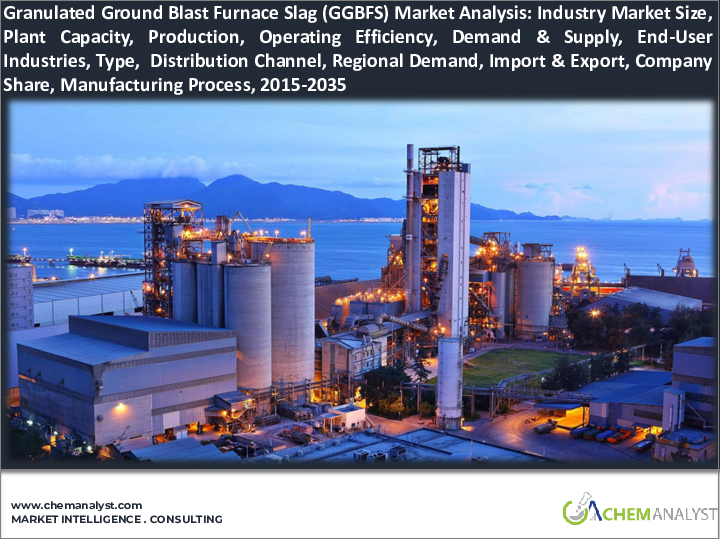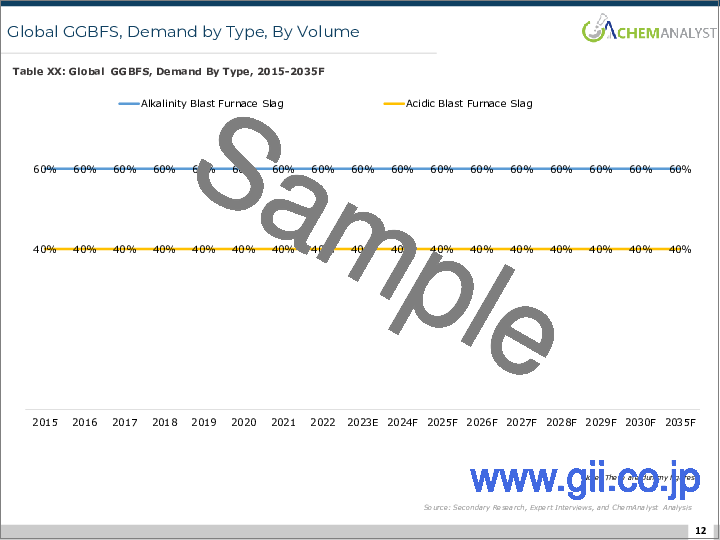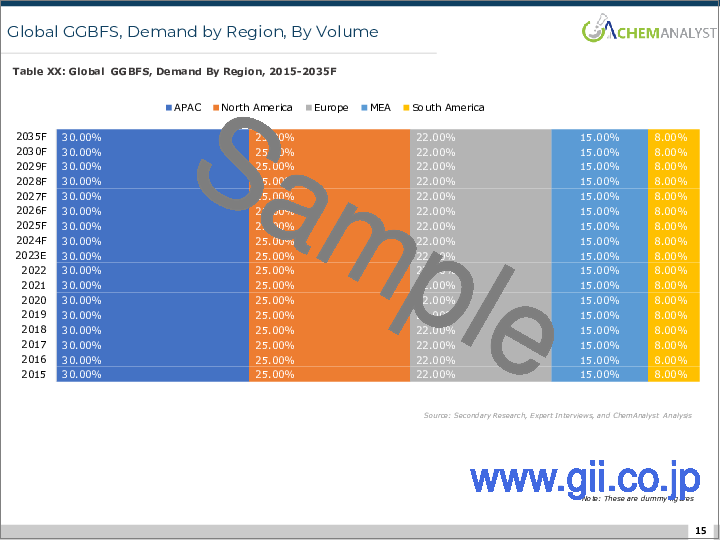|
|
年間契約型情報サービス
商品コード
1225828
高炉水砕スラグ微粉末(GGBFS)の世界市場分析:プラント生産能力、生産、運用効率、需要・供給、エンドユーザー業界、タイプ別の需要、販売チャネル、企業シェア、外国貿易、地域需要(2015年~2035年)Global Granulated Ground Blast Furnace Slag (GGBFS) Market Analysis: Plant Capacity, Production, Operating Efficiency, Demand & Supply, End-User Industries, Demand by Type, Sales Channel, Company Share, Foreign Trade, Regional Demand, 2015-2035 |
||||||
|
|||||||
| 高炉水砕スラグ微粉末(GGBFS)の世界市場分析:プラント生産能力、生産、運用効率、需要・供給、エンドユーザー業界、タイプ別の需要、販売チャネル、企業シェア、外国貿易、地域需要(2015年~2035年) |
|
出版日: 年間契約型情報サービス
発行: ChemAnalyst
ページ情報: 英文
|
全表示
- 概要
- 目次
世界の高炉水砕スラグ微粉末(GGBFS)の市場規模は、2021年に約3億7,700万トンに達し、2035年までの予測期間中にCAGRで3.20%の成長が予測されています。
当データベースでは、世界の高炉水砕スラグ微粉末(GGBFS)市場を調査分析し、市場の概要、セグメント別・地域別の分析、企業シェアなどの情報を提供しています。
オンラインデータベースをPDFまたはExcelとしてダウンロード可能です。データ内のテキスト等のコピー&ペースト及び、データの印刷は可能です。データは四半期ごとに更新されます。
目次
第1章 生産能力:企業別
重要な製造業者と、その現在および将来の高炉スラグ粒状化スラグ(GGBFS)の運転能力に関する最新情報をリアルタイムで入手できる。
第2章 生産能力:ロケーション別
製造業者のロケーションベースの生産能力を分析することにより、高炉水砕スラグ微粉末(GGBFS)の地域供給をより深く理解する。
第3章 生産:企業別
主要企業による高炉水砕スラグ微粉末(GGBFS)の過去の年間生産量を調査し、今後数年間でどのように成長するかを予測する。
第4章 需要:最終用途別
どのエンドユーザー業界(ポートランドセメント・コンクリート、レンガ・ブロック、その他)が市場を形成しているか、また、高炉水砕スラグ微粉末(GGBFS)市場の成長予測を発見する。
第5章 需要:地域別
北米、アジア太平洋、中東・アフリカ、南米、さまざまな地域での高炉水砕スラグ微粉末(GGBFS)の需要の変化を分析し、地域の需要のマッピングを指示する。
第6章 需要:販売チャネル別(直接・間接)
高炉水砕スラグ微粉末(GGBFS)の販売には、複数のチャネルが使用される。業界の売上の大部分を代理店やディーラー、または直接販売が占めているかどうかを分析するのに役立つ。
第7章 需要:タイプ別
多様なタイプ、アルカリ性高炉スラグと酸性高炉スラグのタイプ、およびそれらの需要について分析する。戦略設計の際に、どのタイプに集中するかを選択できる。
第8章 需給ギャップ
高炉水砕スラグ微粉末(GGBFS)の貿易黒字と赤字に関する情報を得るために需給ギャップを決定する。
第9章 企業シェア
高炉水砕スラグ微粉末(GGBFS)の市場シェアのうち、現在、世界中の主要企業が占める割合を把握する。
第10章 輸出:国別
高炉水砕スラグ微粉末(GGBFS)の主要国の輸出量に関する詳細を取得する。
第11章 輸入:国別
高炉水砕スラグ微粉末(GGBFS)の主要国の輸入量に関する詳細を取得する。
The global Granulated Ground Blast Furnace Slag (GGBFS) market has reached around 377 million tonnes in 2021 and is expected to grow at a CAGR of 3.20% during the forecast period until 2035.
Granulated Ground Blast Furnace Slag (GGBFS) is a by-product of the iron blast furnace process. In this process, iron ore, limestone, and coke are reacted to a temperature of approximately 1500°C in the furnace. GGBFS displays unique properties like it is highly resistant to chemicals, salty water, freezing and thawing. When GGBFS is added to concrete, the property of concrete is improved. Granulated Ground Blast Furnace Slag (GGBFS) improves the compressive strength, longer durability, and utility of concrete.
Based on type, Granulated Ground Blast Furnace Slag (GGBFS) market has two types available which are, Alkalinity Blast Furnace Slag and Acidic Blast Furnace Slag. Wherein the major portion is held by Alkalinity Blast Furnace Slag with around 73% of the global market in 2021. The slag is helpful for longevity of concrete which promotes its strength and utility. Also, Granulated Ground Blast Furnace Slag (GGBFS) helps as an insulating material.
The primary market drivers of GGBFS are the Portland Cement & Concrete Industry. In 2021, this industry held a market share of approximately 69% of global GGBFS market. Granulated Ground Blast Furnace Slag when crushed or milled to very tiny cement-sized particles, displays geopolymeric qualities that make it a viable additive for Portland cement. The Granulated Ground Blast Furnace Slag (GGBFS) consumption is anticipated reach around 585 million tonnes by 2035.
The dominating region that demands the most significant volume in Asia Pacific Region. Owing to rapid industrialization and new construction projects, the demand of cement and concrete will rise in developing nations like India, which is anticipated to result in expansion of GGBFS market. Currently, China is the highest producer of Granulated Ground Blast Furnace Slag (GGBFS). China Baowu Steel Group Corp. holds the highest capacity and operates exclusively in Jiangsu and Wuhan City.
Based on the end-user industry, the Granulated Ground Blast Furnace Slag (GGBFS) market has various uses in construction industry like Portland Cement & Concrete, Bricks & Blocks, and Others. The slag is deployed for land filling and other commercial purposes as well. However, Portland Cement & Concrete is the biggest end-user market of Granulated Ground Blast Furnace Slag, which is expected to increase the GGBFS demand in the upcoming years.
Significant companies for Global Granulated Ground Blast Furnace Slag (GGBFS) market are China Baowu Steel Group Corp., Ltd, Nippon Steel Corporation, ArcelorMittal S.A., JFE Steel Corporation, Maanshan Iron & Steel Company Limited, Changcheng Special Steels Co Ltd, Baosteel, Hunan Valin Xiangtan Iron and Steel Co., Ltd., Zenith Steel Group Co. Ltd., Gansu Jiu Steel Group Hongxing Iron and Steel Co ltd., TATA Steel and Others.
Years considered for this report:
Historical Period: 2015- 2021
Base Year: 2021
Estimated Year: 2022
Forecast Period: 2023-2035
The objective of the Study:
- To assess the demand-supply scenario of Granulated Ground Blast Furnace Slag (GGBFS), which covers the production, demand, and supply of Granulated Ground Blast Furnace Slag (GGBFS) around the globe.
- To analyze and forecast the market size of Granulated Ground Blast Furnace Slag (GGBFS).
- To classify and forecast the Global Granulated Ground Blast Furnace Slag (GGBFS) market based on end-use and regional distribution.
- To examine global competitive developments such as new capacity expansions, mergers & acquisitions, etc., of the Granulated Ground Blast Furnace Slag (GGBFS) market.
To extract data for the Global Granulated Ground Blast Furnace Slag (GGBFS) market, primary research surveys were conducted with Granulated Ground Blast Furnace Slag (GGBFS) manufacturers, suppliers, distributors, wholesalers, and Traders. While interviewing, the respondents were also enquired about their competitors. Through this technique, ChemAnalyst was able to include manufacturers that could not be identified due to the limitations of secondary research. Moreover, ChemAnalyst analyzed various segments and projected a positive outlook for the Global Granulated Ground Blast Furnace Slag (GGBFS) market over the coming years.
ChemAnalyst calculated Granulated Ground Blast Furnace Slag (GGBFS) demand around the globe by analyzing the historical data and demand forecast, which was carried out considering the production of raw material to produce Granulated Ground Blast Furnace Slag (GGBFS). ChemAnalyst sourced these values from industry experts and company representatives and externally validated them by analyzing the historical sales data of respective manufacturers to arrive at the overall market size. Various secondary sources, such as company websites, association reports, annual reports, etc., were also studied by ChemAnalyst.
Key Target Audience:
- Granulated Ground Blast Furnace Slag (GGBFS) manufacturers and other stakeholders
- Organizations, forums and alliances related to Granulated Ground Blast Furnace Slag (GGBFS) distribution
- Government bodies such as regulating authorities and policy makers
- Market research organizations and consulting companies
The study is useful in providing answers to several critical questions that are important for industry stakeholders such as Granulated Ground Blast Furnace Slag (GGBFS) manufacturers, customers, and policy makers. The study would also help them to target the growing segments over the coming years, thereby aiding the stakeholders in taking investment decisions and facilitating their expansion.
Report Scope:
In this report, Global Granulated Ground Blast Furnace Slag (GGBFS) market segments into following categories, in addition to the industry trends which have also been detailed below:
- Market by End-use: Portland Cement & Concrete, Bricks & Blocks, and Others
- Market, by Sales Channel: Direct Sale and Indirect Sale
- Market, by Region: North America, Europe, Asia Pacific, Middle East and Africa, and South America.
Available Customizations:
With the given market data, ChemAnalyst offers customizations according to a company's specific needs.
Table of Contents
Table of Content
1. Capacity By Company
On our online platform, you can stay up to date with essential manufacturers and their current and future operation capacity on a real-time basis for Granulated Ground Blast Furnace Slag (GGBFS).
2. Capacity By Location
To better understand the regional supply of Granulated Ground Blast Furnace Slag (GGBFS) by analyzing its manufacturers' location-based capacity.
3. Production By Company
Study the historical annual production of Granulated Ground Blast Furnace Slag (GGBFS) by the leading players and forecast how it will grow in the coming years.
4. Demand by End- Use
Discover which end-user industry (Portland Cement & Concrete, Bricks & Blocks, and Others) are creating a market and the forecast for the growth of the Granulated Ground Blast Furnace Slag (GGBFS) market.
5. Demand by Region
Analyzing the change in demand of Granulated Ground Blast Furnace Slag (GGBFS) in different regions, i.e., North America, Europe, Asia Pacific, Middle East and Africa, and South America, which can direct you in mapping the regional demand.
6. Demand by Sales Channel (Direct and Indirect)
Multiple channels are used to sell Granulated Ground Blast Furnace Slag (GGBFS). Our sales channel will help in analyzing whether distributors and dealers or direct sales make up most of the industry's sales.
7. Demand by Type
Lean about the diverse types, Alkalinity Blast Furnace Slag and Acidic Blast Furnace Slag types, and their demands. It will allow you to choose which type to concentrate on when designing your strategy.
8. Demand-Supply Gap
Determine the supply-demand gap to gain information about the trade surplus or deficiency of Granulated Ground Blast Furnace Slag (GGBFS).
9. Company Share
Figure out what proportion of the market share of Granulated Ground Blast Furnace Slag (GGBFS) is currently held by leading players across the globe.
10. Country-wise Export
Get details about quantity of Granulated Ground Blast Furnace Slag (GGBFS) exported by major countries.
11. Country-wise Import
Get details about quantity of Granulated Ground Blast Furnace Slag (GGBFS) imported by major countries.





